| Cobretti2 said: How much power will it require though lol? I saw that the gigabtye GTX690 requires 650W (unless that is a typo on the PC site I checked lol) |
I am not sure. I doubt more than 260W since for single GPUs last time NV tried this with GTX480, the end result was a very loud blower fan style videocard. I presume they'll keep it at 250W or less. GTX690 uses about 275W at load in games (http://www.techpowerup.com/reviews/Club_3D/HD_7870_jokerCard_Tahiti_LE/26.html). A solid 650W from Corsair, Seasonic, PC Power& Cooling, Enermax, Antec should sufficie easily. You really need to watch out if you are going to use Socket 2011 CPUs/mobo or FX8150-8350 which use way more power at stock and a lot more overclocked.

| Pemalite said: Haswell will only be an incremental performance increase over Ivy Bridge, just like Ivy Bridge was only incremental over Sandy Bridge. - You're looking at 10-15% performance improvement tops. |
Ivy Bridge is just a refresh+, meaning most of the performance increases came through a 3-4% increase in IPC, a slight bump in clocks/Turbo Boost and performance gain on the GPU side. Haswell is not the same as SB--> IVB since it's actually a significantly revised microarchitecture. It will be more like moving from Nehalem to Sandy Bridge. While you are most likely right that IPC will only move 10-15%, there are potential larger upsides in Haswell. Although I agree with you that if you consider anything less than 2x the performance increase marginal, then of course Haswell is not a revolutionary upgrade like going from 2006 Q6600 to the 2012 i7 3770K would be.
IMO, the best time to upgrade CPUs on the Intel side is on the TOCKs because that's when 90% of the advanced architecture tech gets introduced, while refreshes is just a die shrink with minor changes. In the last 6 years most of the refreshes from Intel have been disappointing, especially Westmere and Ivy Bridge. For that reason there is little reason to wait for Broadwell in 2014 as Haswell should have 90% of the performance boost that Broadwill will bring.
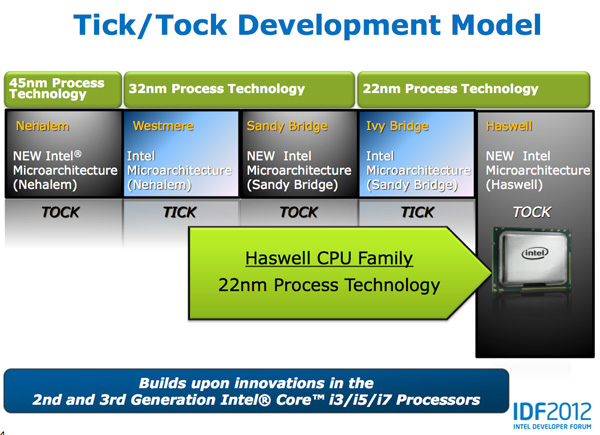
For simplicity sake SB and IVB is really the same architecture even though Intel calls IVB "3rd" generation. It's really marketing.
Nehalem/Lynnfield = Core i7 9xx/8xx/7xx are the 1st generation.
Sandy/Ivy = Core i5 2xxx/3xxx are really the true 2nd gen
Haswell is actually the 3rd new gen, but Intel will call it 4th for marketing reasons and Haswell 5th.
Because TOCKs have major changes, Haswell will introduce new AVX2 instructions and double the floating point operations/instruction performance (this is important for games for example)
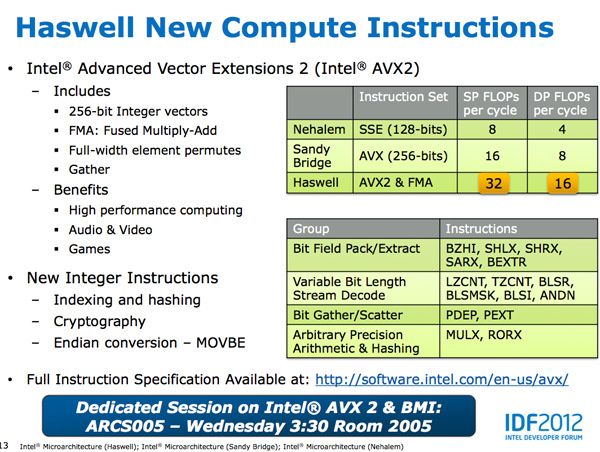
The increase in floating point performance is going to be the largest in the last 5 years on the Intel side, since Nehalem i7 920 was introduced in 2008.
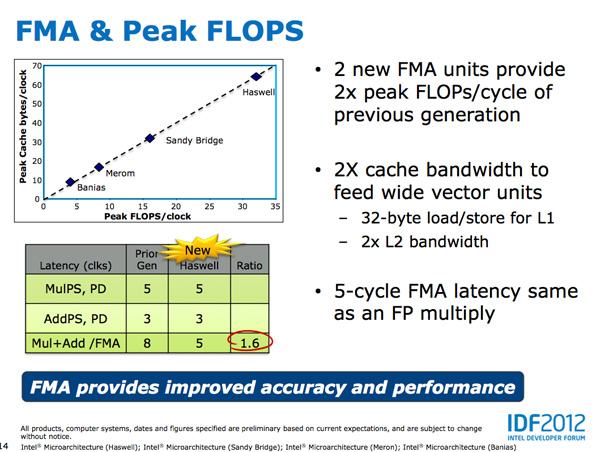
The CPU cache bandwidth is doubling, in many cases a much larger jump than going from Nehalem to SB was, where in many cases Intel kept things unchanged.
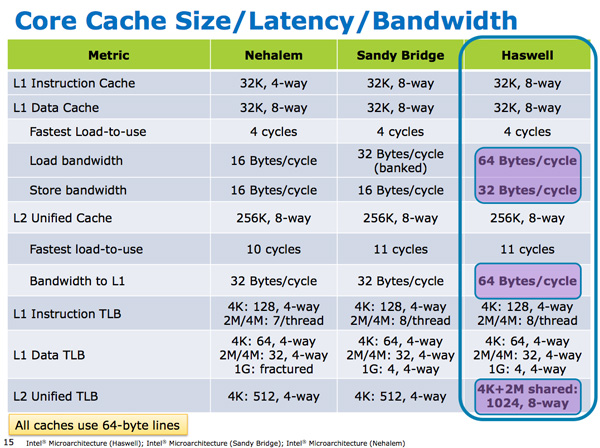
There is also a new Random Number Generator function that will speed up complex Excel calculations like Monte Carlo simulation if you use that sort of thing in university courses. Excel functions like Crystal Ball/Monte Carlo optimization calculations should improve 30-40% from this Haswell feature.
There are also should be image quality and video encoding speed improvements with QuickSync. If you make HD quality videos or encode movies or something, the new version of QuickSync will be better than in IVB: http://www.anandtech.com/show/6355/intels-haswell-architecture/13
There is also native 4K video encoding support in Haswell, although this should be introduced to Ivy Bridge as well according to Intel but I don't think they have done it yet (don't hold me on that :)).
| Pemalite said: The only interesting part about Haswell IMHO will be if Intel ditches the idea of using cheap thermal paste which limited the overclocks in Ivy Bridge. |
Let's say 10% increase in IPC on average (more in floating point tasks --> great for CPU limited games), and if TIM is replaced with fluxless solder and overclocking goes up from 4.5ghz on IVB to 4.9-5.0ghz, you'd be looking at ~20% increase in performance with OC + IPC. That's not a game changer but I wouldn't call that marginal like going from SB to IVB was.
Also, Intel is going to make Base Clock overclocking more flexibible like it is right now on Socket 2011. That should improve control over overclocking since we'll be able to alter both the Multiplier and the Base Clock increments in steps to make it easier to narrow down exact overclock.
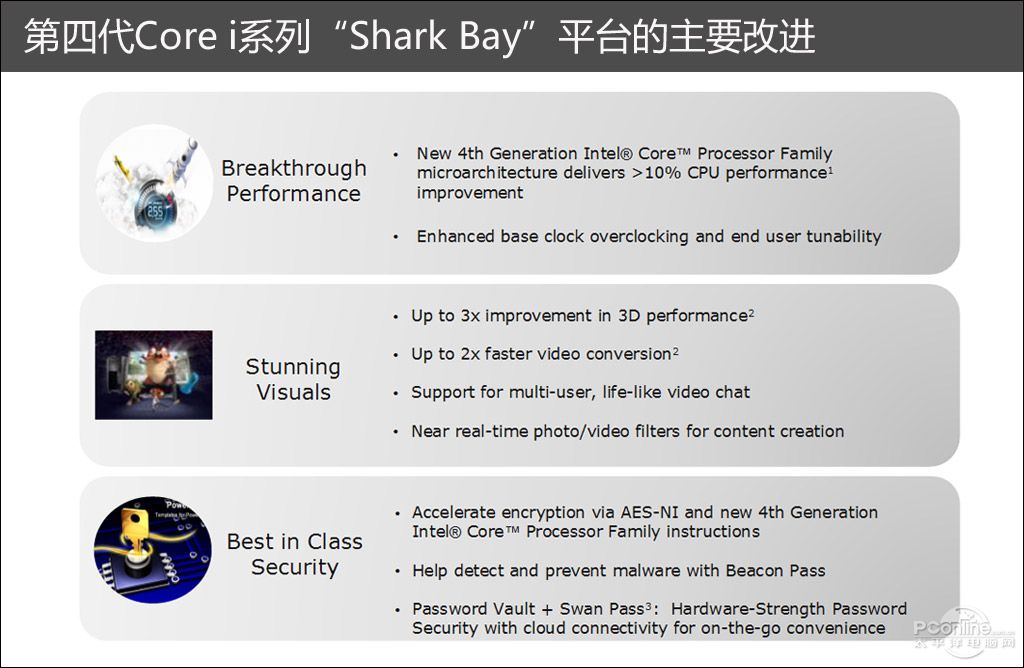
| Pemalite said: Besides Haswell will be more expensive than Ivy Bridge for a fair while as it uses a completely new platform and hence you will pay the early adopter tax on both the motherboard and processor. |
Since when does Intel raise prices on new CPUs when it replaces them? It hasn't happened in half a decade unless you have access to MicroCenter or Fry's that discount older generations to get rid of them. Even then the difference between 2500K and 3570K tends to be $15 right now. With a budget of $1,200-1,500 it wouldn't make it worthwhile to save $15-20 on purchasing an i5 3570K/i7 3770K instead of spending a little extra on i5 4670K/i7 4770K.
Regarding the motherboard, for the first time in a consumer CPUs Intel is going to integrate the Voltage Regulation onto the same die as the CPU. With Haswell, the CPU is rumored to have up to 16 power phases right on the die! Right now lower-end $90-150 Z77 motherboards have 4-12 power phases. Count the grey little squares around the CPU socket:

http://www.newegg.com/Product/Product.aspx?Item=N82E16813128544&Tpk=gigabyte%20z77%20ud3h
Not only that but the VRMs on Haswell are all digital. Some motherboards in the $100-140 range do not have digital power delivery. That means in terms of "quality" components on the motherboard and clean power, Haswell should also be an upgrade for budget overclockers since every single Haswell quad will have much better voltage components standard than many lower end boards have via 3rd party VRMs.
Because the Integrated Voltage Regulation will be on die and close to the CPU, designed specifically for Haswell, in theory, noise, voltage ripple, interference, should all be improved. Integrated VR may or may not improve overclocking on Haswell over IVB but it's a possibility.


Since the VRMs will be integrated onto the CPU package, it'll be even harder for motherboard manufacturers to stand out and try to sell you on "overclocking" VRM power phases and so on. If anything, we are seeing motherboard manufacturers delivering more features over the years at lower prices to remain relevant.
For example take Asrock Z77 Extreme 4. It has so many features that not long ago were only found on $170-180 boards! Back in the days if you wanted PCIe 2.0 x8/x8 split for SLI / CF you needed to spend $170-180 on a motherboard. Now you can get that on $120 boards.
Same story with Thunderbolt. You can now get Thunderbolt connector on $160 boards:
http://www.newegg.com/Product/Product.aspx?Item=N82E16813130665
And 2x Thunderbolt ports on a $185 board:
http://www.newegg.com/Product/Product.aspx?Item=N82E16813128558
In the past you need to spend $200-240 just for 1 of those.
For motherboard manufacturers to survive next generation against each other, they will need to offer even more features at lower prices because trying to sell us 16-32 VRMs is no longer going to cut it for justifying raising prices $30-40 over mainstream boards. I am sure some will still do this but it probably won't be a selling featurer as much as it was before.
The only bad thing about Haswell is the launch date keeps moving around. A lot of sources keep pointing to June, instead of April :(


| Pemalite said: As for the Geforce 700 and Radeon 8000 series, again. It will only be incremental, about the equivalent in jump between the Radeon 5000 to the 6000 series or the jump between the Geforce 400 to 500 series. |
You are probably right but a lot of times you get nice price cuts to clear out old generation as well as previous flagship performance at mid-high end prices.
GTX480 - March 2010 $499
Refresh --> GTX570 with similar performance around November 2010 for $349
GTX680 - March 2012 $499
Refresh --> GTX770 with similar performance of a 680 for $349. That means the level of GPU performance of GTX670/HD7950 V2 might even fall to $279 or lower with cards like HD8870. It's a possibility, although I am purely guessing. I am obviously not expecting a doubling in performance.
| Pemalite said: I say, buy the best you can afford now, always something better around the corner, it's not like your PC suddenly won't be able to play games when the yearly refreshes are released. |
Of course there is always something better around the corner but there are some still certain points in time you could upgrade at the wrong time. Why would you buy Intel's CPU architecture that will be nearly 2 years old by February 2013? Why would you buy a $400 GTX680 in February 2013? That's not a smart way to upgrade. It's like buying a GTX580 in November 2011 for $450 when we knew HD7900 series is launching in January 2012. You can't perfectly time PC upgrades but there are definitely ways to improve your upgrade cycles if it means waiting 2 more months.
If someone intends to keep the CPU for 4 years, are you willing to put down the claim that Double the floating number of calculations and AVX2 instructions will not matter in future programs/game?
Newer games often use more modern gaming code and start being coded around new instructions and newer CPU architectures perform those instructions quicker. They have more advanced branch prediction which minimizes cache misse and latency. Next thing you know the normal 15% IPC between Nehalem and Sandy Bridge grows to a lot more.

You can really start to see the CPUs separating from each other based on the generation they came from. In most games you aren't going to see this, but if you keep the CPU for 3-4 years, the 10% increase in IPC will grow as games will use more modern code that will simply work faster on Haswell.

















